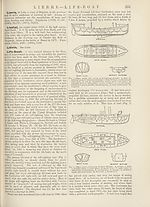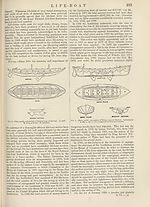New volumes of the Encyclopædia Britannica > Volume 30, K-MOR
(260) Page 232
Download files
Complete book:
Individual page:
Thumbnail gallery: Grid view | List view

232
LIFE-BOAT
electrical propulsion and oil fuel might have been used in
the steam life-boats, but the experiment with the latter,
which had a fair trial in the earlier boats budt, was not
very successful, and it was not repeated in the later boats.
The idea of employing electricity was, after the most care¬
ful consideration, regretfully abandoned. TIm highest
speed attained by the first hydraulic steam life-boat was
rather more than 9 knots, and that secured in the latest
knots. _ . ,
The other types of pulling and sailing life-boats are all
non-self-righting, and are specially suitable for the require¬
ments of the different parts of the coast on which they are
placed. Their various qualities will be understood by a
glance at the illustrations (Figs. 3, 4, 5, 6, and 7). _
The Institution continues to build life-boats of different
sizes according to the requirements of the various points
of the coast at which they are placed, but of late years the
tendency has been generally to increase the dimensions of
the boats as the smaller ones become worn out or obsolete.
BODY PLAN.
MIDSHIP SECTION.
Fig. 3.—Plans, profile, and section of Cromer type of life-boat. A, deck ; B,
relieving valves for automatic discharge of water off deck ; C, side air-cases
above deck ; E, wale, or fender ; G, water-ballast tanks.
This change of policy is mainly due to the great trans¬
formation which has taken place in the shipping of all the
trading nations, the small coasters and fishing-boats having
in great measure disappeared, their places being taken by
steamers and steam trawlers. The cost of the building
and equipping of pulling and sailing life-boats has materi¬
ally increased, more especially since 1898, the increase
being mainly due to improvements and the seriously aug¬
mented charges for materials and labour. In 1881 the
average cost of a fully-equipped life-boat and carriage was
£650, whereas at the end of 1901 it amounted to £1000,
the average annual cost of maintaining a station having
risen to more than £100.
The transporting-carriage continues to be a most
important part of the equipment of life-boats, generally
of the self-righting type, and is absolutely indispensable
where it is necessary to convey the boats for the purpose
of launching to any point not in the immediate vicinity
of the boat-house. It is not, however, usual to supply
carriages to boats of larger dimensions than 37 feet in
length by 9 feet beam, those in excess as regards length
and beam being either launched by means of special slip¬
ways or kept afloat. The transporting-carriage of to-day
is, however, an improvement on that used in 1881,
and has been rendered particularly useful at places
where the beach is soft, sandy, or shingly, by the intro¬
duction in 1888 of Tipping’s sand-plates. These very-
efficient adjuncts to easy and prompt launching are com¬
posed of an endless plateway or jointed wheel tyre fitted
to the main wheels of the carriage, thereby enabling the
boat to be transferred with rapidity and with greatly de¬
creased labour over beach and soft sand. Further effici¬
ency in launching has also been attained at many stations
Fio. ,4.—Plans, profile, and section of Liverpool type of life-boat. A, B, C,
E, G, as in Fig. 3 ; B, end air-compartments ; F, iron keel; H, drop-keels.
by the introduction in 1890 of pushing-poles, attached to
the transporting-carriages, and of horse launching-poles,
first used in 1892. Fig. 8 gives a view of the modern
transporting-carriage fitted with Tipping’s sand- or wheel-
plates.
The life-belt has since 1898 been considerably im¬
proved, being now less cumbersome than formerly, and
BODY PLAN MIDSHIP SECTION
Fig. 5.—Plans, profile, and section i Norfolk and Suffolk type of life-boat
A, B, E, F, G, H, as in Fig. 4 ; A, side deck ; I, cable-well.
more comfortable. The feature of the principal im¬
provement is the reduction in length of the corks under
the arms of the wearer and the rounding - off of the
upper portions, the result being that considerably more
freedom is provided for the arms. The maximum extra
buoyancy has thereby been reduced from 25 lb to
22 lb, which is more than sufficient to support a man
heavily clothed with his head and shoulders above the
water, or to enable him to support another person besides
LIFE-BOAT
electrical propulsion and oil fuel might have been used in
the steam life-boats, but the experiment with the latter,
which had a fair trial in the earlier boats budt, was not
very successful, and it was not repeated in the later boats.
The idea of employing electricity was, after the most care¬
ful consideration, regretfully abandoned. TIm highest
speed attained by the first hydraulic steam life-boat was
rather more than 9 knots, and that secured in the latest
knots. _ . ,
The other types of pulling and sailing life-boats are all
non-self-righting, and are specially suitable for the require¬
ments of the different parts of the coast on which they are
placed. Their various qualities will be understood by a
glance at the illustrations (Figs. 3, 4, 5, 6, and 7). _
The Institution continues to build life-boats of different
sizes according to the requirements of the various points
of the coast at which they are placed, but of late years the
tendency has been generally to increase the dimensions of
the boats as the smaller ones become worn out or obsolete.
BODY PLAN.
MIDSHIP SECTION.
Fig. 3.—Plans, profile, and section of Cromer type of life-boat. A, deck ; B,
relieving valves for automatic discharge of water off deck ; C, side air-cases
above deck ; E, wale, or fender ; G, water-ballast tanks.
This change of policy is mainly due to the great trans¬
formation which has taken place in the shipping of all the
trading nations, the small coasters and fishing-boats having
in great measure disappeared, their places being taken by
steamers and steam trawlers. The cost of the building
and equipping of pulling and sailing life-boats has materi¬
ally increased, more especially since 1898, the increase
being mainly due to improvements and the seriously aug¬
mented charges for materials and labour. In 1881 the
average cost of a fully-equipped life-boat and carriage was
£650, whereas at the end of 1901 it amounted to £1000,
the average annual cost of maintaining a station having
risen to more than £100.
The transporting-carriage continues to be a most
important part of the equipment of life-boats, generally
of the self-righting type, and is absolutely indispensable
where it is necessary to convey the boats for the purpose
of launching to any point not in the immediate vicinity
of the boat-house. It is not, however, usual to supply
carriages to boats of larger dimensions than 37 feet in
length by 9 feet beam, those in excess as regards length
and beam being either launched by means of special slip¬
ways or kept afloat. The transporting-carriage of to-day
is, however, an improvement on that used in 1881,
and has been rendered particularly useful at places
where the beach is soft, sandy, or shingly, by the intro¬
duction in 1888 of Tipping’s sand-plates. These very-
efficient adjuncts to easy and prompt launching are com¬
posed of an endless plateway or jointed wheel tyre fitted
to the main wheels of the carriage, thereby enabling the
boat to be transferred with rapidity and with greatly de¬
creased labour over beach and soft sand. Further effici¬
ency in launching has also been attained at many stations
Fio. ,4.—Plans, profile, and section of Liverpool type of life-boat. A, B, C,
E, G, as in Fig. 3 ; B, end air-compartments ; F, iron keel; H, drop-keels.
by the introduction in 1890 of pushing-poles, attached to
the transporting-carriages, and of horse launching-poles,
first used in 1892. Fig. 8 gives a view of the modern
transporting-carriage fitted with Tipping’s sand- or wheel-
plates.
The life-belt has since 1898 been considerably im¬
proved, being now less cumbersome than formerly, and
BODY PLAN MIDSHIP SECTION
Fig. 5.—Plans, profile, and section i Norfolk and Suffolk type of life-boat
A, B, E, F, G, H, as in Fig. 4 ; A, side deck ; I, cable-well.
more comfortable. The feature of the principal im¬
provement is the reduction in length of the corks under
the arms of the wearer and the rounding - off of the
upper portions, the result being that considerably more
freedom is provided for the arms. The maximum extra
buoyancy has thereby been reduced from 25 lb to
22 lb, which is more than sufficient to support a man
heavily clothed with his head and shoulders above the
water, or to enable him to support another person besides
Set display mode to:
![]() Universal Viewer |
Universal Viewer | ![]() Mirador |
Large image | Transcription
Mirador |
Large image | Transcription
Images and transcriptions on this page, including medium image downloads, may be used under the Creative Commons Attribution 4.0 International Licence unless otherwise stated. ![]()
| Encyclopaedia Britannica > New volumes of the Encyclopædia Britannica > Volume 30, K-MOR > (260) Page 232 |
|---|
| Permanent URL | https://digital.nls.uk/193570881 |
|---|
| Attribution and copyright: |
|
|---|---|
| Shelfmark | EB.18 |
|---|---|
| Description | Ten editions of 'Encyclopaedia Britannica', issued from 1768-1903, in 231 volumes. Originally issued in 100 weekly parts (3 volumes) between 1768 and 1771 by publishers: Colin Macfarquhar and Andrew Bell (Edinburgh); editor: William Smellie: engraver: Andrew Bell. Expanded editions in the 19th century featured more volumes and contributions from leading experts in their fields. Managed and published in Edinburgh up to the 9th edition (25 volumes, from 1875-1889); the 10th edition (1902-1903) re-issued the 9th edition, with 11 supplementary volumes. |
|---|---|
| Additional NLS resources: |
|

